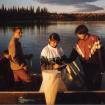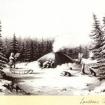Medicine
Raspberry
Mooseberry (soapberry)
Juniper (crowberry)
High-bush cranberry
As medicine
The leaves of the high-bush cranberry plant are crushed and applied to relieve bee-stings and burns.
Source: Andre, Alestine, Nan t'aih nakwits'inahtsìh (The Land Gives Us Strength) (2006)
Bladderwort
As medicine:
Either the leaves or the whole bladderwort plant including the roots are made into a tea to treat kidney or bladder infection. The bladderwort and the horsetail plant are used in the same way for bladder ailments. Ruth usually makes her bladderwort tea strong but dilutes it before drinking it. Ruth said,
Cranberry
As food
Blueberry
As food
Blueberries are tasty and can be eaten as is or used in jams, pies, muffins, and it’suh, a Gwich’in dessert made from pounded dry fish. As a medicinal tea, the stems and leaves of the blueberry plant can be boiled and taken for cold symptoms.
As medicine
Water lily, Yellow pond lily
As medicine:
The roots of the water lily plant are dried and used to relieve a dry throat or the onset of a cold. Ruth Welsh said,
"...you only take small little tiny pieces."
The roots are also used to ease a sore back. Ruth describes how to make this,
…cut a piece off [the main root]…a foot or a foot and a half long…heat the root….split the root and put it on each of [the] back and tie [it in place].
Source: Andre, Alestine, Nan t'aih nakwits'inahtsìh (The Land Gives Us Strength) (2006)
Blackberry
As food
The berries are edible and make good jam. They are ready to pick in August and September and are tasty when eaten as is or eaten with other berries. Blackberries can be mixed with cranberries and added to it’suh, a Gwich’in dessert made from pounded dryfish.
Blackberries and Fish
Pages
- « first
- ‹ previous
- 1
- 2
- 3
- 4



